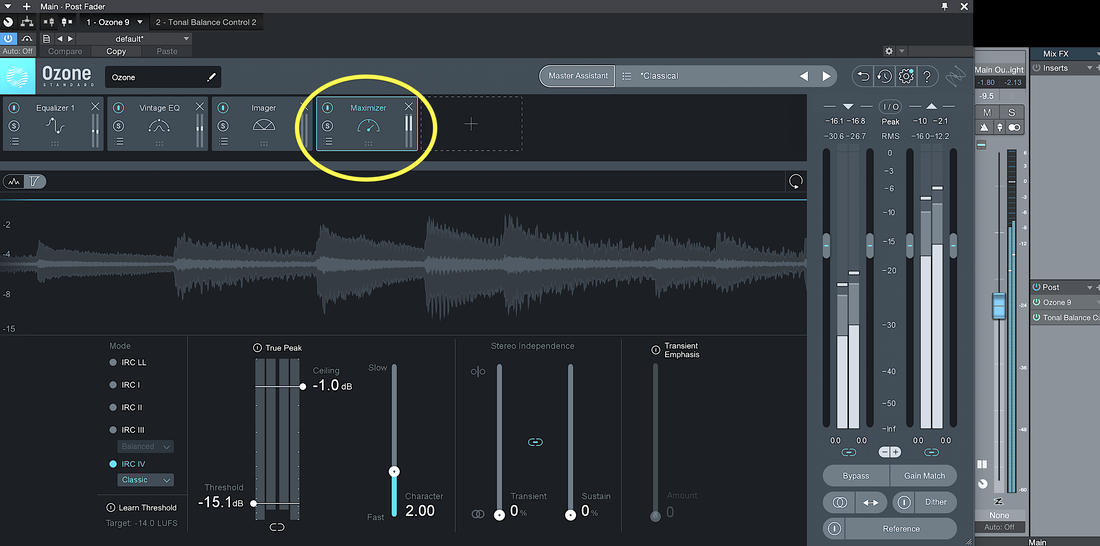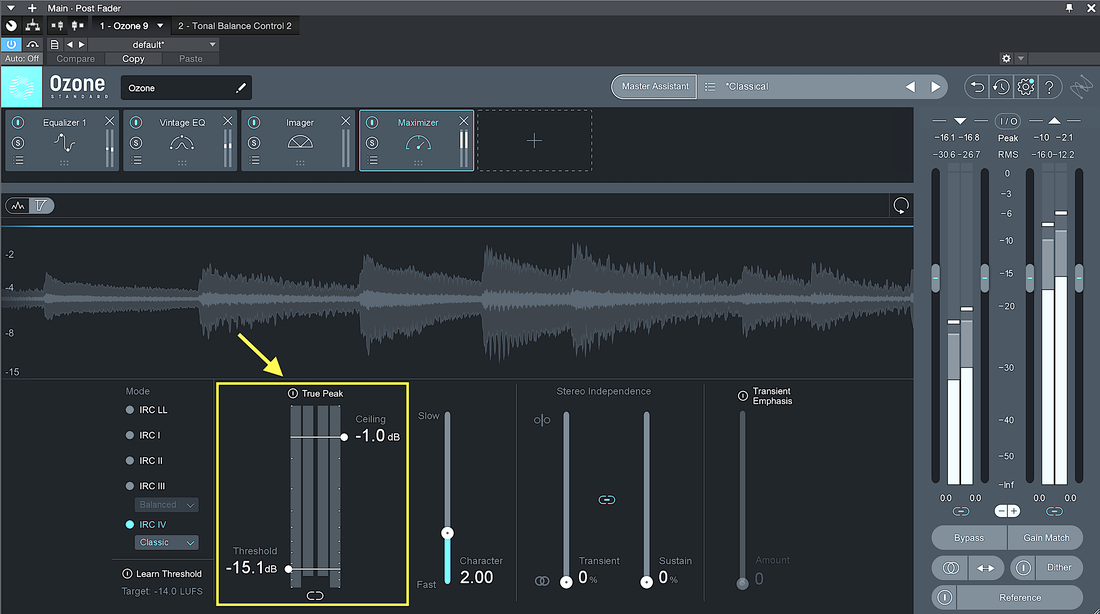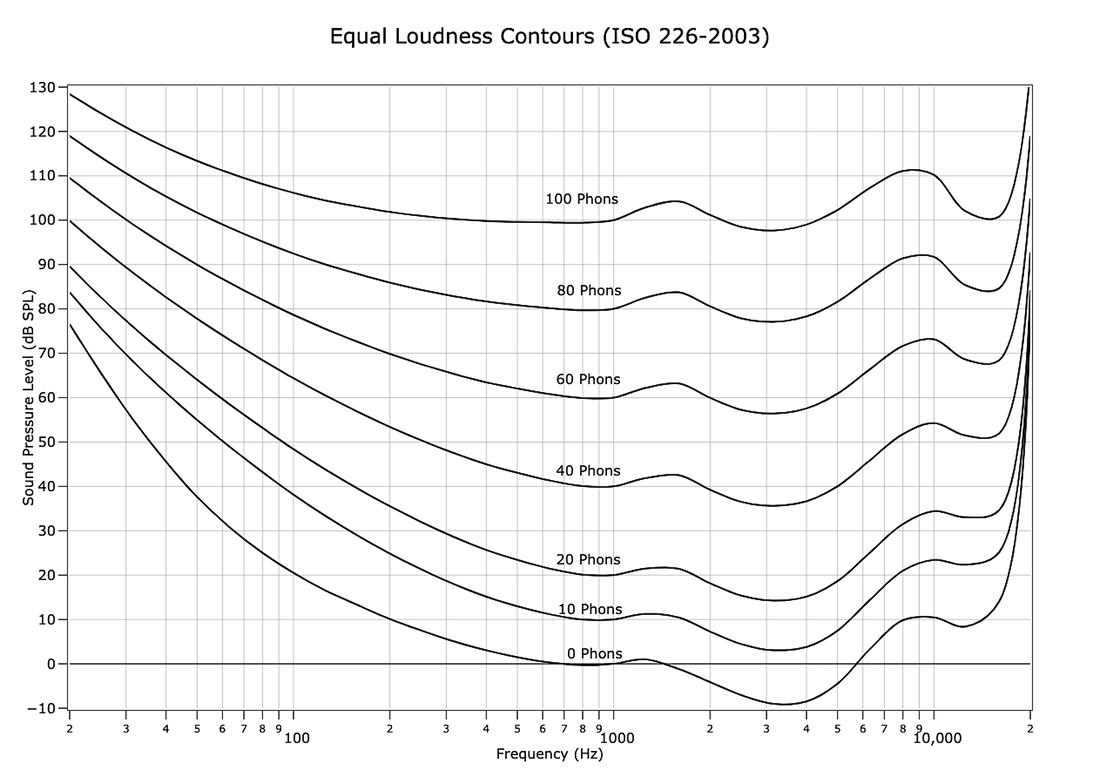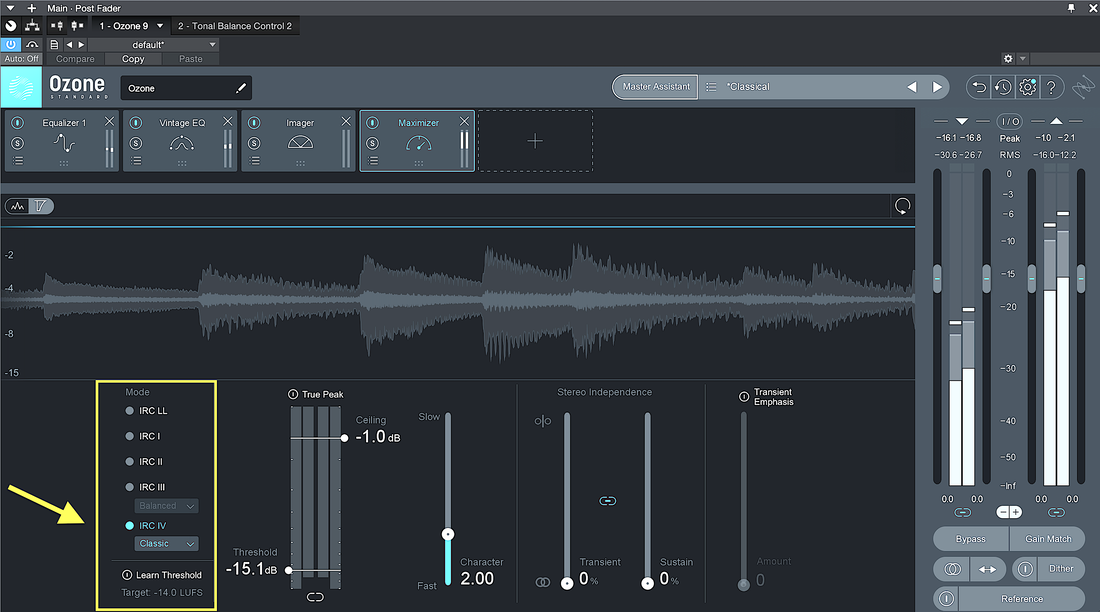|
Music Studio |
|
The final mastering process in the chain of post-fader inserts in the Main Output stereo bus is loudness normalization and brickwall limiting. This signal processing is done in the iZotope Ozone Maximizer plug-in, shown in the figure above. The Maximizer is used to bring the average volume level of the mix up to a desired level while maintaining peak levels below the digital clipping level (0 dBFS). This process is known as “brickwall limiting” since it is like using a compressor with a very high compression ratio (n>> 10) as a limiter. But the Maximizer is a special kind of limiter. It prevents the peak signal from going above a chosen ceiling level, typically in the range -1.0 to -0.3 dBFS. Therefore, the limiter protects against the terrible distortion caused by clipping of the digital signal. The plug-in uses “look ahead” samples to see peaks coming down the pike. And it can use intersample peak (ISP) metering to see “true” peaks. In the figure above, you can see that the ceiling level is set at -1.0 dBFS. The threshold level at which the limiting process engages is set at -15.1 dBFS. Since the threshold level also determines the amount of gain (dB) added to input level by the Maximizer plug-in, it has a significant effect on the overall average loudness and dynamic range of the song. In this example, the gain applied to the input signal is given by, Gain (dB) = Ceiling (dBFS) – Threshold (dBFS) = -1.0 dBFS – (-15.1 dBFS) = 14.1 dB At this point, we need to say a few words about loudness “normalization” – adjusting your song loudness level to come close to reference (or target) levels chosen by the various music streaming services. These target levels are simply ‘goals’ for you to shoot for. A given music streaming service will “measure” the loudness of your song, and adjust it to its own common reference level. How a streaming service measures and adjusts your levels (the normalization process) is not standardized across the industry. As of mid 2021, Spotify uses International Telecommunication Union (ITU) Standard BS1770 to measure audio program loudness and true-peak audio level. Spotify’s target marks are time-integrated loudness level of -14 dB LUFS (see below) and true-peak (TP) level of -1 dBFS (often written as -1 dB TP) The “loudness” of a song can be measured by metering the amplitude of the signal waveforms. Average (RMS) and peak amplitude meters are most commonly used. This kind of loudness is a property of the signals only. But how about a measurement of the perceived loudness – what the human ear actually hears ? This requires quite a bit of knowledge of the perception part of human psychoacoustics, such as the equal loudness contours of the Fletcher-Munson curves. For each contour of constant loudness (units of Phons), you can see below that there is a wide variation in sound wave pressure level (dB SPL) across the frequency spectrum. For example, it takes a much higher sound wave pressure level ( roughly +20 dB higher) to hear low-frequency sound at the same loudness as mid-frequency sound. The 0 Phons curve corresponds to the threshold of hearing. The threshold of pain is approximately at 120 Phons. This is where the modern loudness measure “LUFS” comes in. LUFS stands for Loudness Units relative to Full Scale, and it’s based on the way our ears (and brains) react to the intensity of sound at different frequencies. With LUFS, mastering engineers can make a loudness measurement that takes everything into account. It’s the perception-based, time-integrated average loudness relative to the digital signal full-scale level of 0 dBFS. Another important setting on the iZotope Ozone Maximizer is the selection of an “Intelligent Release Control (IRC)” mode of operation. Back in the previous post on compression, the Release Time of the compressor was described. It is the time delay (in milliseconds) from when the signal level falls below the threshold to the de-activation of the compressor. An appropriate release time helps avoid ‘pumping’, the audible unnatural level changes associated primarily with the release of the compressor. A faster release behavior can result in a less noticeable pumping effect. There are four IRC algorithms in the Maximizer plug-in that preserve the dynamics and overall clarity of your mix. Mode IRC III allows for aggressive limiting by using an advanced psychoacoustic model to intelligently determine the speed of limiting that can be applied to the incoming signal, before producing distortion that is detectable to the human ear. Mode IRC IV builds upon the IRC III technology by shaping the spectrum to further reduce pumping and distortion. As the signal level goes farther above the threshold level, the IRC IV algorithm limits frequency bands that contribute most to these peaks. Dozens of psychoacoustically-spaced frequency bands are utilized in order to achieve a more natural and transparent effect. The IRC III and IRC IV algorithms are very CPU-intensive, and produce high latency, especially at higher sampling rates.
Finally, the overall response time (attack and release times) of the limiter processing can be tweaked using the Character slider bar shown in the figure above. The actual attack and release times used are dependent on the selected IRC Mode. A continuous range from Fast (0.0) to Slow (10.0) is available in each mode. Comments are closed.
|
Categories
All
Archives
May 2023
|




 RSS Feed
RSS Feed
